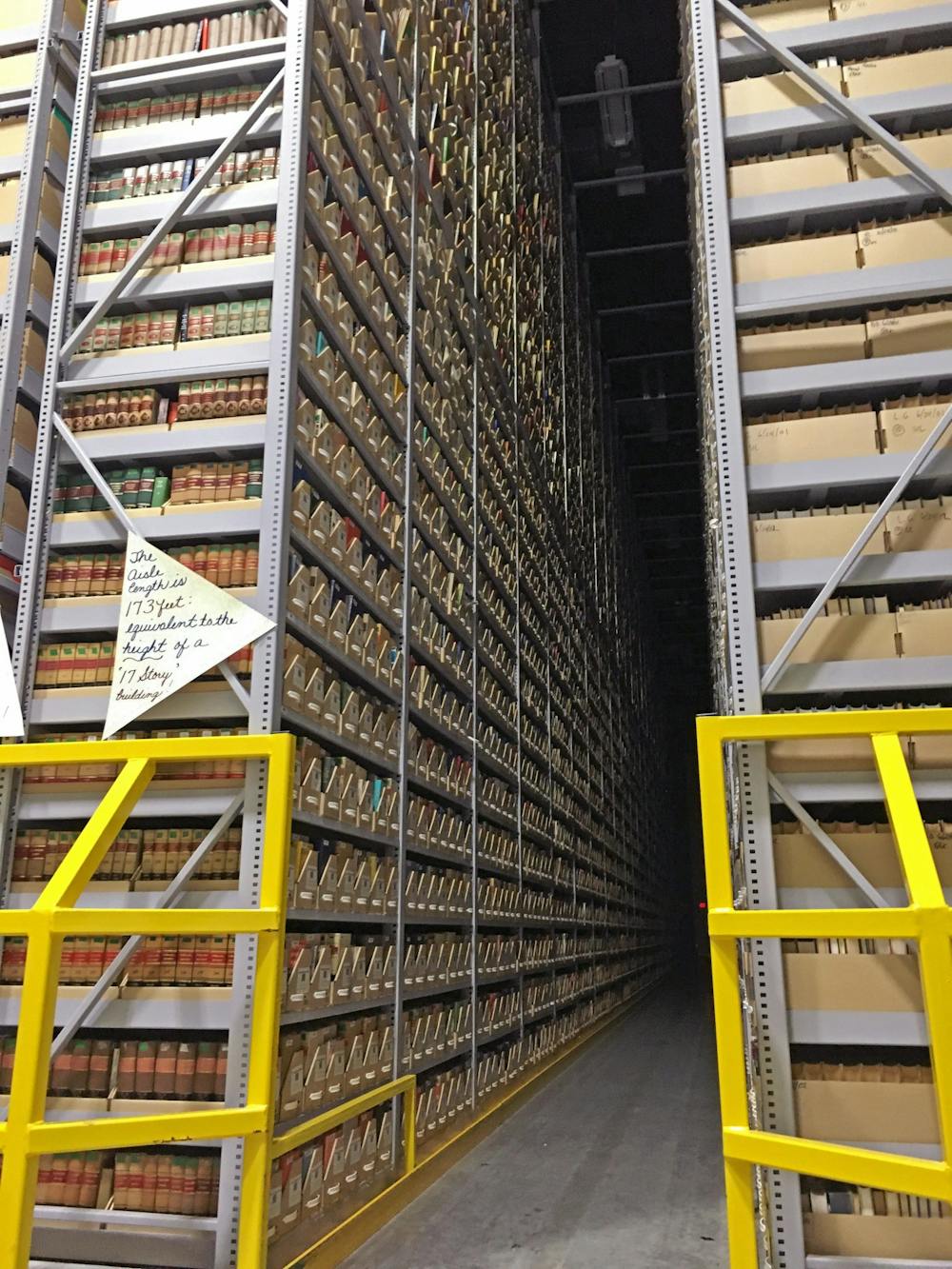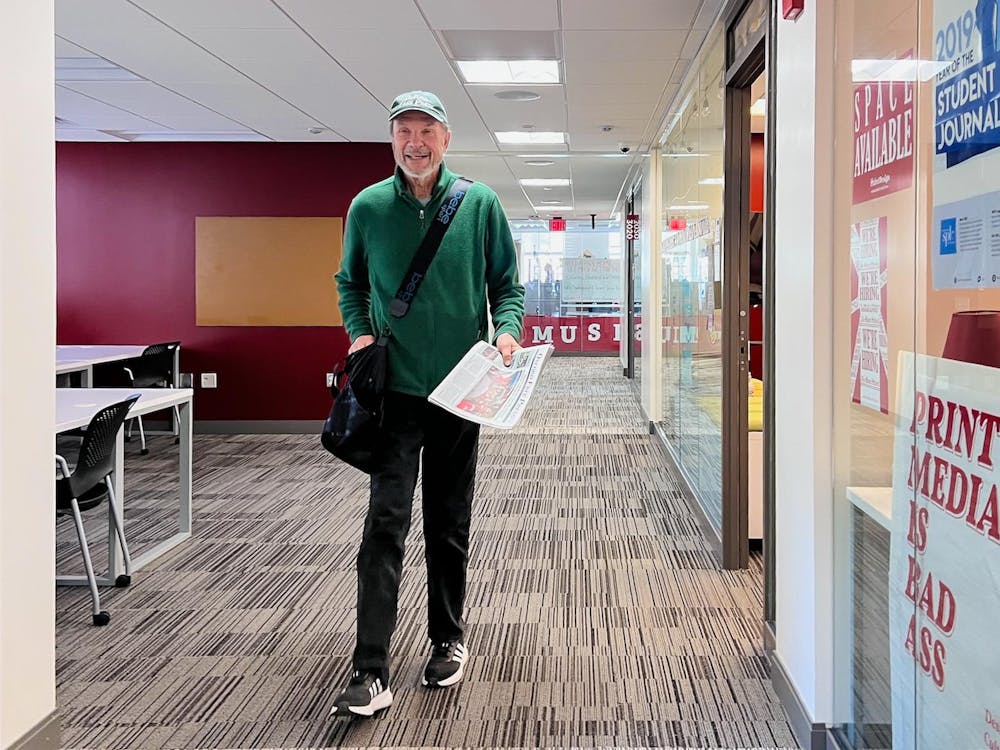The interior of the Southwest Ohio Regional Depository (SWORD) is as quiet as a cathedral and cool as a cave. It’s climate controlled, kept between 58 and 65 degrees and at 40 to 50 percent humidity to protect its contents. It has the look of a warehouse, with rows and rows of 30-foot shelves towering above anyone who walks in.
On those shelves are about 2.5 million books, periodicals and other resources like microfilm, LP records and archival materials — SWORD employees have to use an elevated work platform, similar to a cherry picker, just to reach most of them. Each item has a barcode and is organized not by author, title or call number, but by size.
“We’re here for efficiency,” said Pam Lipscomb, depository manager.
Many of these items have not been touched in a long time, and for the vast majority, this place is their final destination.
The stacks in college libraries across the country have shrunk and even disappeared completely in recent years as more and more resources have become available online. Though Miami University’s libraries still have their bookshelves, space is a hot commodity, and not every book can be kept forever. Many of them are recycled when they are deemed to be no longer needed. Some of them go to the depository.
SWORD is one of five depositories in Ohio; there is one in each corner of the state and one in Columbus, on The Ohio State University’s (OSU) campus. SWORD mainly receives shipments from four universities: Miami, Wright State University, the University of Cincinnati and Central State University. In fiscal year 2019, Miami sent about 1,500 items to SWORD.
The depositories are not open for public browsing. If someone wants to check something out, they must request it through one of the universities. SWORD had 7,500 requests for books and 1,400 for articles in fiscal year 2019. Each time they receive a request, they manually retrieve the item from the towering shelves and mail it to the university within a day or two.
Miami’s libraries are constantly reevaluating their collections. Sixteen librarians oversee the process of “weeding,” or deciding which books and journals to remove from the shelves. Each year, these librarians choose what books to buy for their discipline’s area and the number that they get rid of must equal how many they purchased — they follow a “zero-growth policy,” said Kevin Messner, head of the Advise and Instruct department, which supervises the subject librarians.
“I try to provide as much flexibility and freedom to each of the librarians to weed according to whatever criteria they think are best, as long as they hit their target,” Messner said.
There is one loophole to this policy — the librarians can buy as many digital copies as they want without having to remove a single print copy.
When deciding which books to weed out, the librarians look at which ones are required for classes in their discipline or disciplines, as well as which ones have not entered circulation for a while — sometimes longer than a decade.
When the depositories first opened in the 90s, Miami and other universities would send most of the books they weeded there, but now that they are mostly full, Miami will only send something to SWORD if it is the last of its kind in the state, Messner said. The rest are recycled — that number changes each year, but Messner estimated a rough average of 4,000 - 6,000.
Enjoy what you're reading?
Signup for our newsletter
SWORD is at 99 percent capacity, Lipscomb said, and although there is space to add on two more modules to the building, there isn’t money for it. The depositories are directly funded by the Ohio Department of Higher Education, and Lipscomb said she doesn’t foresee being able to expand anytime soon. All the depositories are facing a lack of space, although the one at OSU is projected to expand since it secured university funding.
“It all really depends on the funding from the state,” Lipscomb said.
The depositories don’t weed books the same way the libraries do, but as the amount of empty shelves shrinks, the SWORD employees have other ways of conserving space — mainly, by disposing of duplicates. If, for example, a particular set of journals exists at more than one of the five depositories, all but one depository will recycle theirs, so there is only one physical copy in the state.
Some of them are digitized, but not all and not necessarily most. And for some of the more delicate materials, the digitization process can be destructive.
Though the use of e-books and especially online journals is popular — Miami faculty and students downloaded 1.3 million serials in fiscal year 2018 — print is far from obsolete. That same year, print circulation reached more than 64,000, while only about 38,500 full e-books were downloaded — although there were about 600,000 downloads of specific chapters, said Nick Kneer, strategic communication coordinator for university libraries. There has been a decline in print circulation over the past decade or so, Messner said, but it has been surprisingly slight and regular.
“Book circulation has [had] single digit declines, but a fairly regular decline each year, and that’s just as people drift more and more towards electronic resources,” Messner said.
Kneer said there are no current plans to get rid of the stacks entirely.
Messner, who has worked in Miami’s library system for more than a decade, said that some disciplines tend to use physical books more than others. Though it’s hard to pin down the numbers, he has noticed that STEM students and faculty are more likely to use online periodicals while those in the humanities are more likely to check out something in print. Additionally, there are always those who prefer to learn from a page rather than a screen.
“There’s something about physically holding a book that a lot of people find important,” Kneer said.
Miami’s libraries have done other things to adapt to the digital age other than digitizing reading material. Also available through the library online are information databases on many different subjects, free subscriptions to The New York Times and Wall Street Journal, apps to facilitate learning, and live chatting with Miami librarians.
The library is not just a place to do research. There, students can study — the study room key at King Library was by far the most checked out item last year, Kneer said. They can create — library computers are enabled with Adobe Creative Cloud, AutoCAD and other softwares that students would otherwise have to pay for, and the Makerspace on the third floor established last year includes sewing machines and a 3-D printer. And they can engage, as the library puts on events every year.
“We want the libraries to be seen as sort of this hub where we’re connecting you to whatever you need,” Kneer said.
Correction: An earlier version of this article misstated the number of full e-books downloaded through university libraries in 2018.




